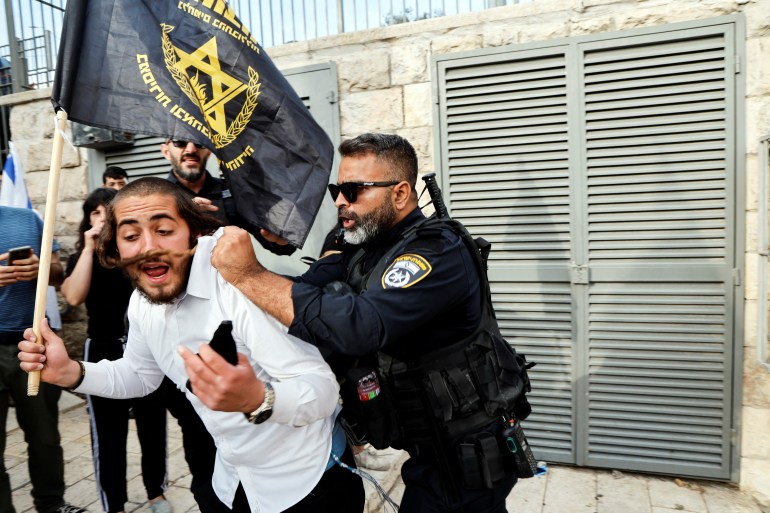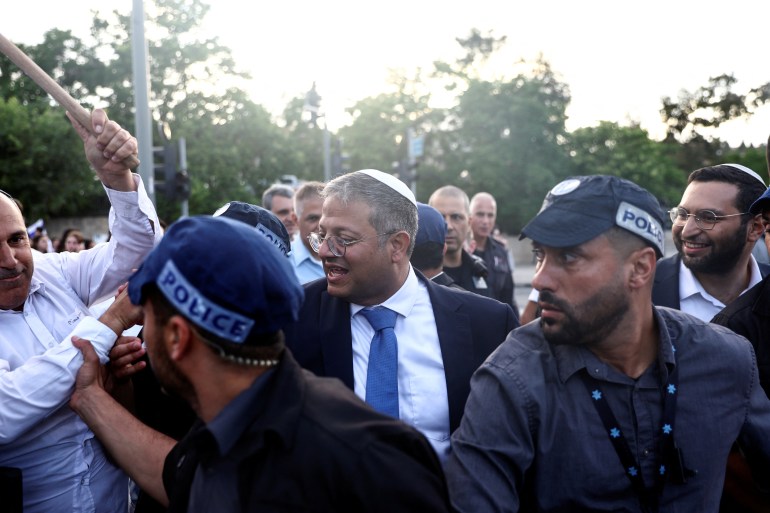Occupied East Jerusalem – “We need an annual day to remind the Arabs that we control the [Old City’s Muslim Quarter] … If we marched some other route, they would grow to think that they rule over this area.”
The speaker, a teenager who did not give his name, was one of the thousands of young marchers who had made the trip to occupied East Jerusalem’s Old City on Thursday for the annual far-right “flag march”, together with his Yeshiva (Jewish religious high school).
The event, held on “Jerusalem Day”, which marks the 1967 capture and annexation of East Jerusalem, a move considered illegal under international law, has led to violence in recent years, as far-right Israelis shout provocative slogans and insults, as well as physically attack Palestinians and even journalists.
Among those attending, there is an unmistakable sense of Jewish supremacy and a passionate religious calling underlying the march.
Before the procession gathered at the Damascus Gate and then snaked through the Old City, hundreds of ultranationalists entered the Al-Aqsa Mosque compound, even as ultra-Orthodox Jews dispersed pamphlets explaining that it was forbidden under Jewish law to ascend.
The religious Zionist Jews, some wearing shirts with inflammatory messages, however, have not adhered to that prohibition, leading to the tense situations that often greet their arrival at Al-Aqsa, the third-holiest site in Islam and a Palestinian national symbol.
Palestinian Muslims sitting at the Qibli Mosque in the compound chanted at the far-right Israelis, while others sat quietly reading the Qur’an.
By the time the main event began, at about 4pm (13:00 GMT) in the afternoon, many streets in the normally bustling Old City were empty, with Palestinian storeowners largely listening to Israeli police recommendations that they close their businesses for the day to avoid any confrontation with the marchers.
And yet, despite attempts by the estimated 2,500 police officers to stop any incidents, some scuffles did inevitably take place.
One man, an Italian supporter of the Palestinian cause wearing a keffiyeh scarf around his neck, was harassed by Israeli marchers, one of whom threatened to kill him.
The police, however, were able to mostly prevent any more serious fights from taking place, largely by keeping the far-right marchers away from everyone else.

Jewish power
People attending the march appeared eager to flaunt the tolerance, and even active encouragement, of their position from the Israeli government, particularly with the presence of Israeli government ministers and politicians throughout the day, including far-right Itamar Ben-Gvir, who became the first cabinet minister to ever attend the march. The far-right Finance Minister Bezalel Smotrich also later attended.
Israeli Prime Minister Benjamin Netanyahu called the march “a splendid day on which to celebrate our return to our eternal capital”.
But Eliyahu, a marcher from Gush Etzion who came as part of a group called Jewish Truth – formed by a group who consider themselves even more to the far-right than Ben-Gvir, said the minister should resign.
“Ben-Gvir left the truth,” Eliyahu said. “He should leave the government.”
For Eliyahu, the event was an opportunity to openly display his far-right position and chant in support of the deportation of Palestinians from their homeland.
“I am feeling joy because we occupied a lot of our country, [but] I feel very sad [we cannot go to Al-Aqsa],” Eliyahu said, before adding that his favourite chant was “Kahane was right”, a reference to the late ultranationalist Rabbi Meir Kahane, who inspired the Jewish gunman who killed 29 Palestinians in Hebron’s Ibrahimi Mosque massacre in 1994, and established Kach, a party that was later declared a “terrorist” organisation in Israel.
“We need to transfer out the Arabs,” Eliyahu said. “We should have flattened Gaza last week.”
“Kahane was right”, along with “Death to the Arabs” was a common refrain from many, but not all, of the marchers, hoisting thousands of Israeli flags and shouting through loudspeakers, throughout the day.

Palestinians kept away
Across the street from the Damascus Gate, where thousands of Jewish Israelis sang euphorically, dozens of Palestinian shops, markets and restaurants were closed off to public access, resembling the situation in the Old City itself.
One Palestinian Christian shopkeeper told Al Jazeera that the shops had been closed to avoid any vandalisation from march attendees.
There have been fears in the lead-up to the event that they could lead wider violence, with the situation in the occupied West Bank and Gaza already tense, following more than a year of almost-daily Israeli raids that have killed hundreds of Palestinians, and a four-day conflict between Israel and the Palestinian Islamic Jihad in Gaza that left at least 33 Palestinians and one Israeli dead.
For Palestinians, events like the flag march serve as a reminder of the continuing occupation, and the treatment that many now refer to as “apartheid”.
“We Palestinians receive the message that this is the day they celebrate on our account,” said Fakhri Abu Diab, a community leader in East Jerusalem whose al-Bustan community faced demolition by the Israeli authorities.
Abu Diab had earlier on Thursday been detained in Al-Aqsa while he was being interviewed by an Israeli media outlet.
He said that he was later released, but not before being told he was banned from the Old City for the rest of the day.
“They don’t want me to talk on this day of their celebration – even to Israeli media,” Abu Diab said. “They prefer we stay in our homes and don’t disturb their celebration of conquering us.”


